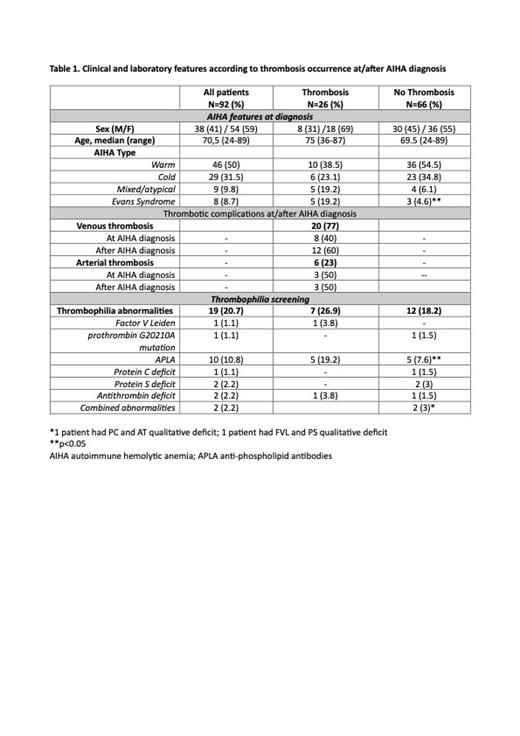Background
Autoimmune hemolytic anemia (AIHA) is characterized by an increased rate of thrombosis, whose predictors are not completely clarified, although an association with active hemolysis (i.e., LDH >1.5 x ULN), anemia severity and previous splenectomy has been reported. Moreover, antithrombotic prophylaxis and its duration are not standardized in this patient-population. The value of thrombophilia screening, including congenital and acquired abnormalities, has not been established yet.
Aim
To investigate the prevalence of inherited and acquired thrombophilia abnormalities in a cohort of AIHA patients with or without thrombosis.
Methods
AIHA patients followed from January 2019 until September 2022 at a tertiary hematologic center in Milan, have been systematically tested for Factor V Leiden (FVL) and prothrombin (FII) G20210A mutation, protein C (PC), protein S (PS), antithrombin (AT) levels, and the presence of antiphospholipid antibodies (APLA, i.e., lupus anticoagulant, LAC, anti-cardiolipin and anti-b2-glycoprotein-1). Patients' hematological characteristics, additional thrombotic risk factors, history of venous/arterial thrombosis before and after AIHA diagnosis, and anticoagulant and/or antiplatelet therapies were retrospectively recorded.
Results
As shown in table 1, 59% of 92 enrolled patients were female with a median age at diagnosis of 70.5 years (range 24-89), and were classified as warm AIHA (50%), cold agglutinin disease (31.5%), mixed/atypical AIHA (9.8%), and Evans syndrome (association of AIHA and other immune cytopenia, 8.7%). Thrombophilia screening resulted positive in 19 patients (20.7%) including FVL (1.1%), F II (1.1%), APLA (10.8%), PC deficiency (1.1%), PS deficiency (2.2%), AT deficiency (2.2%), and more than one abnormality (2.2%). Additional risk factors considered were thrombosis prior to AIHA diagnosis, reported in 6 patients (7%, 3 venous and 3 arterial), and associated conditions (29%), including autoimmune disease (N=17), lymphoproliferative disease (N=7), myeloproliferative neoplasm (N=1), and paroxysmal nocturnal hemoglobinuria (N=1). Furthermore, 97% of subjects presented at least one risk factor (i.e., diabetes, obesity, bed rest, etc.) in addition to AIHA. Twenty-seven patients (28%) received anticoagulant prophylaxis after AIHA diagnosis, mainly short-term for hemolysis (42%) or surgery of lower limb fractures (37%), and long-term for atrial fibrillation in 24%; 22% of patients were on antiplatelet prophylaxis, and 4 patients had been splenectomized. Since AIHA diagnosis, 26 patients (28%) experienced thrombosis (77% venous, 23% arterial), with 33 total events (3 patients had > 1 event). Median hemoglobin and LDH at thrombosis were 8.6 g/dL (2-11.7), and 374 U/L (129-1873) respectively, indicating active hemolysis. No relationship was found with inherited thrombophilia abnormalities (3 patients, 8% experienced thrombosis vs 7, 10.5% who did not), whilst a significant association was noted with APLA positivity (p<0.05). Two patients with APLA experienced more than 1 event, one had 1 venous and 1 arterial event.
Conclusions
Along with disease activity and Evans syndrome, positivity for APLA appears the main predictor of thrombosis in AIHA and is therefore worth of testing, whilst extensive thrombophilia screening encompassing inherited abnormalities appears less useful.
Disclosures
Barcellini:Novartis: Consultancy, Honoraria, Speakers Bureau; Alexion, AstraZeneca Rare Disease: Consultancy, Membership on an entity's Board of Directors or advisory committees, Research Funding.


This feature is available to Subscribers Only
Sign In or Create an Account Close Modal